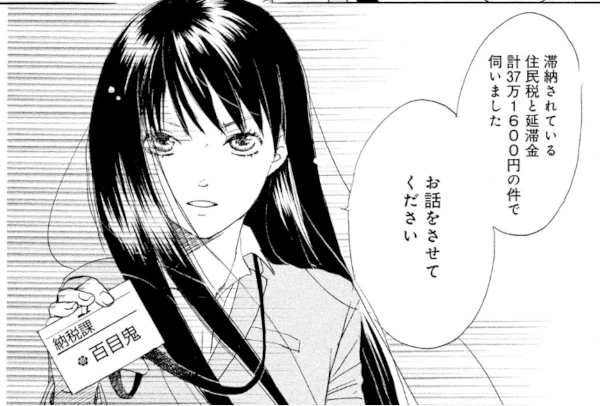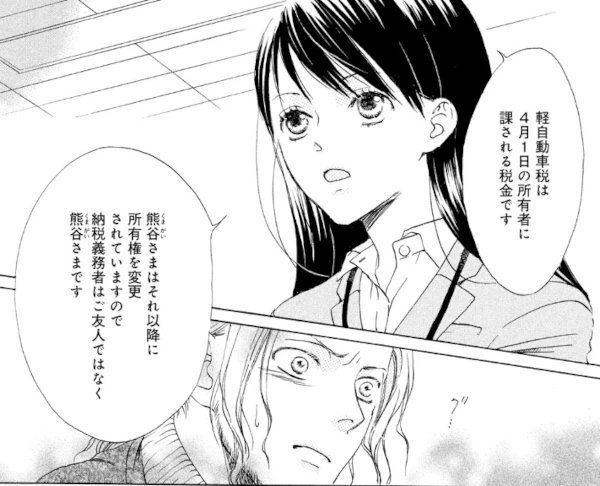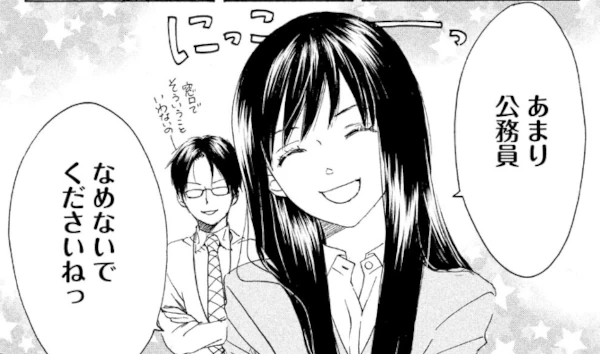This time, we’re introducing Zeicho! - Nouzeika Daisan Shuunoukakari—a manga perfect for learning appropriate business敬語 in the service industry.
Work Information

Zeicho! - Nouzeika Daisan Shuunoukakari (ゼイチョー! ~納税課第三収納係~)
Author: Yui Shin
Publisher: KODANSHA
Amount of text: plentiful
Challenge level: ★★★
Latest volume : Vol.5(Feb.2024 / Completed)
Story overview
Hanako Doumeki, who works in the Tax Payment Division at the Kouno City Hall, is a new employee known for her unpredictable behavior despite her cool appearance. She often does things like stabbing her pen into the desk in front of customers. Paired with the laid-back and flashy civil servant, Soichiro Aiba, they confront delinquent taxpayers with honesty every day!
Why this manga is suitable for learning Japanese
The dialogue includes many examples of proper honorific language.
The main character, Hanako, works in the tax payment division at the city hall and uses very proper honorific language when dealing with citizens, who are her clients. In the realistic situations where she asks citizens to pay their overdue taxes, readers can learn solid and impeccable examples of honorific language in conversations.

You can learn detailed information about Japan’s tax system.
This work is a very rare type of manga set in the tax payment division of a city hall, with taxes as its main theme. As readers progress through the story, they will gain detailed knowledge about Japan’s tax system, a topic even many Japanese people are not very familiar with.

Phrase Spotlight
Keigo in Action: Polite Yet Firm Business Speechご納得の上ご納付いただけるように全力を尽くします
This phrase is a great example of how Japanese business keigo balances politeness and professionalism. The use of respectful expressions makes the request sound formal yet considerate, rather than demanding. This type of language is essential in government offices, customer service, and business settings.

Understanding Respectful Language in This Scene
In this panel, the protagonist uses 敬語 (keigo)—the formal and respectful speech commonly found in government, business, and customer-service settings. Her speech includes two key forms of keigo: 尊敬語 (sonkeigo, respectful language) and 謙譲語 (kenjōgo, humble language).
For beginners learning Japanese, the difference between sonkeigo and kenjōgo can be challenging. This is because both forms involve making a statement more polite, but in opposite ways:
・Sonkeigo elevates the listener or the subject of the action.
・Kenjōgo lowers the speaker or their in-group to show humility.
In this scene, the character is addressing taxpayers in a formal setting, requiring a balance of politeness and authority—a hallmark of keigo in government communication.
A common pattern in government-related敬語 is:
・Using respectful prefixes like ご (go) or お (o) for nouns and verbs.
・Using humble expressions like いただく (itadaku) instead of morau to make requests sound polite.
・Softening direct demands with indirect phrasing to maintain formality.
Below are key phrases from the image, along with their explanations:
1.「わかっています」
(“I understand.”)
・わかっています (wakatte imasu) – This is 丁寧語 (polite language), commonly used when speaking respectfully to colleagues or acquaintances. Unlike 尊敬語 (respectful language for others) or 謙譲語 (humble language for oneself), 丁寧語 is simply a formal way to speak without elevating or humbling anyone in particular.
・The use of 〜ています (te imasu) adds a continuous or confirmed nuance, making it sound more professional than just “わかる.”
2.「決して少額ではない税金をご負担いただくのです」
(“They will be bearing a significant tax burden.”)
・ご負担 (go-futan) – The honorific prefix ご adds politeness to futan (burden).
・いただく (itadaku) – A humble verb meaning “to receive,” used to politely phrase obligations.
・The overall sentence presents the tax payment as something the citizen must do, but in a softened and respectful manner.
3.「ご納得のうえご納付いただけるよう全力を尽くします」
(“We will do our best so that you may make your payment with full understanding.”)
・ご納得のうえ (go-nattoku no ue) – “After you fully understand and accept.” The ご prefix makes nattoku (understanding) more polite.
・ご納付いただけるよう (go-nōfu itadakeru yō) – A respectful way of saying “so that we may receive your payment.”
・全力を尽くします (zenryoku o tsukushimasu) – “I will do my best,” a common phrase in customer service.
This dialogue demonstrates how 丁寧語, 尊敬語, and 謙譲語 are strategically used in professional settings, even when speaking to colleagues about customer interactions.
Professional Politeness in Government Communication
This scene provides an excellent example of how business keigo is used in government offices, customer service, and other formal work environments. The phrases demonstrate how officials maintain politeness while addressing serious financial matters, making them valuable for learners studying professional Japanese.
・The speaker acknowledges the listener’s burden (tax payment) with respect.
・The speech is structured to be both professional and empathetic.
・Rather than demanding payment, the speaker frames it as a request and expresses willingness to assist.
This dialogue is a great model for Japanese learners aiming to communicate professionally in business or customer-service settings!
Different from Workplace Keigo: Language for Customer Interactions
The honorific expressions in this scene are not the same as the keigo used when speaking to colleagues or superiors in an office setting. Instead, they reflect the polite and formal language used in customer-facing roles, such as government offices, retail, and hospitality. While this style of speech ensures professionalism and respect, using it with coworkers or bosses in a corporate environment may sound overly stiff or distant.
In this particular scene, Hanako is actually speaking to a colleague about how she interacts with taxpayers, rather than addressing a taxpayer directly. This highlights how even when discussing customer interactions, the expected level of formality remains high. Understanding these nuances is key to using keigo naturally in different situations!
A Little Warning
It contains a lot of information and difficult content
Since taxes are the main theme, the work frequently includes specialized explanations. With a lot of information and high difficulty, it is quite a challenging read.

Not Your Typical Civil Servant: A Line That Breaks the Rules
In this manga, Hanako, a tax officer, has a signature phrase she uses repeatedly:
“なめないでくださいね” (Namenaide kudasai ne) – meaning “Don’t underestimate (me/us), okay?”
The verb “なめる” (nameru) literally means “to lick,” but in this context, it’s a slang expression meaning “to look down on,” “to underestimate,” or “to not take seriously.” Saying this to a customer is highly inappropriate for a government worker, especially someone in a taxpayer-facing role.
In reality, civil servants must always maintain a polite and professional demeanor, even in difficult situations. Hanako’s blunt remark is something no real public official would ever say, making it a line that only works in the world of manga. It adds to her unconventional character and provides a humorous contrast to the usual stiff, formal language expected in government offices!

Work Information

Zeicho! - Nouzeika Daisan Shuunoukakari (ゼイチョー! ~納税課第三収納係~)
Author: Yui Shin
Publisher: KODANSHA
Amount of text: plentiful
Challenge level: ★★★
Latest volume : Vol.5(Feb.2024 / Completed)
This Blog’s ConceptIn this blog, we are introducing manga that are not only highly captivating but also ideal for Japanese language learners. Studying Japanese through manga is both fun and effective. Manga allows you to understand the subtleties of keigo (honorifics), teineigo (polite speech), and casual conversation in Japanese. We hope you find works that match your interests and use them to enhance your Japanese learning journey.